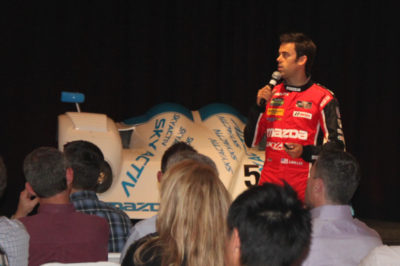Mazda SKYACTIV-D Prototype driver Joel Miller doesn’t just espouse STEM education, he lives it. Stepping into the cockpit with the knowledge that his mechanical engineering degree from University of California, Riverside, gave him, he has an edge that other drivers don’t, and one he puts to use each and every session.
“Engineers talk a totally different language,” says Miller. “I can talk on their level. The reports that each driver writes… the other drivers may just focus on driving. I’m able to bridge that gap. As well, when we’re at the shop, if I can help the other engineers take off one item [from their list], then they’re able to focus on the program on the engines, on the chassis.”
As a racing driver and engineer, he’s the perfect person to speak to the quality of a science, technology, math and engineering – STEM – education. So when Mazda Motorsports and SpeedSource Race Engineering stop at a nearby school before a race weekend with one of their high-tech prototypes in tow, the students know that Miller truly has an understanding of what he talks about. And he’s able to tell the students that STEM education goes way beyond just helping the drivers and engineers at the track, that it applies to everyone in the racing community and beyond.
“More than just car design, engineering and me as a driver who is also a mechanical engineer, beyond that on a race weekend, there’s the television crew…they’re part of the STEM program. There’s a helicopter pilot that’s part of the medical crew; he’s a STEM asset. There’s so much more. You show the kids, after those first three I mentioned – the engineer, the driver, the designer – there’s so much more within motorsports that somebody could do.
“We also relay, specifically on the math side, when the kids say, ‘Awww, I’m never going to use this again….’ Yes you will. And we put real-life applications to the simplest problems, simple addition even,” Miller explains.
Before each race weekend, the Mazda Motorsports crew and SpeedSource team bring their resources to do presentations at schools near the track where they’re competing. There’s a presentation and a question-and-answer session about the race weekend. While awareness of Mazda and its products are part of the day, the main goal is to show students what STEM is and how it relates to motorsports.
“I think we’re inspiring interest,” says Miller. “We speak to a specific group, like a robotics club or their [Advanced Placement] department. But we also do a general one. We get the most questions out of the general one, because of stuff they didn’t think about before.
“My personal goal is that every single time, if I can reach one kid in there and possibly give them a direction – because I know a lot of my friends had no idea what they intended to do later on, and when you reach your senior year, you’ve got to have that in mind – if I could inspire a kid to get to that point sooner, then we did our job.”


 ACCESSIBILITY
ACCESSIBILITY